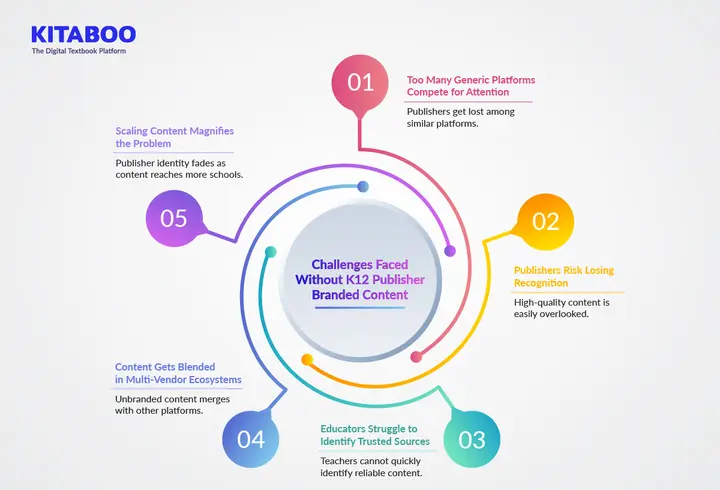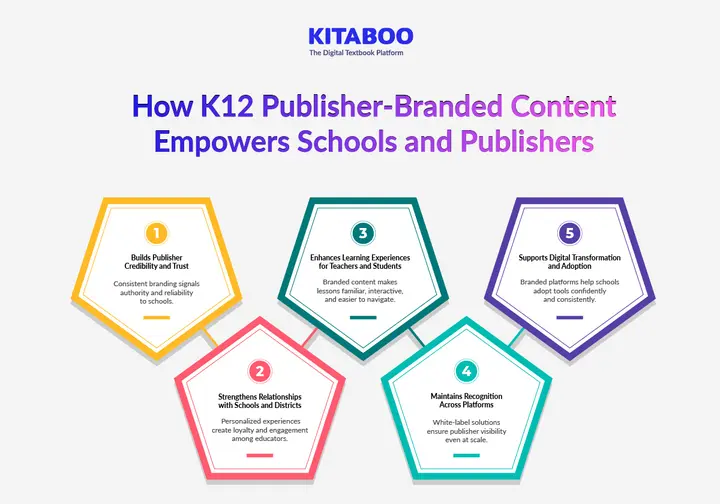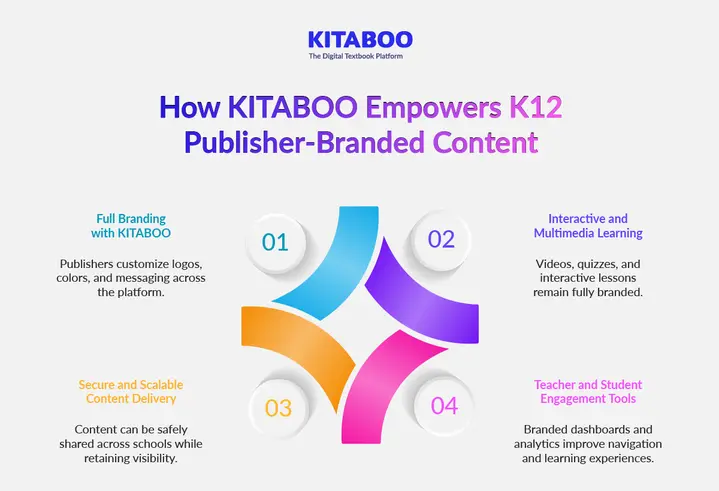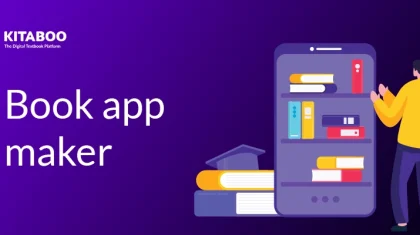
5 Ways Branded Content Empowers K12 Publishers and Schools
Summarize this blog with your favorite AI:
5 Ways Branded Content Empowers K12 Publishers and Schools – TL;DR
Digital classrooms are crowded, and generic platforms make publishers invisible. K12 publisher-branded content helps schools instantly recognize trusted sources, improving adoption and engagement.
Without branding, content gets lost in the crowd. Educators struggle to identify reliable resources, and scaling content magnifies the problem.
White-label EdTech solutions empower publishers and schools. They can maintain publisher-brand identity, deliver branded school content, and provide interactive, consistent learning experiences.
Customizable curriculum platforms enhance engagement, strengthen district relationships, and ensure long-term visibility across classrooms.
| Section | Key Takeaways |
|---|---|
| Challenges Without Branding | Publishers get lost among generic platforms and struggle to maintain recognition. |
| How Branded Content Empowers | Branded content builds credibility, strengthens school relationships, and enhances learning experiences. |
| Maintains Recognition Across Platforms | Branding ensures content is visible and trusted even when scaled widely. |
| How KITABOO Enables Branded Empowerment | KITABOO offers full branding, interactive multimedia, secure delivery, and engagement tools. |
| Supports Digital Transformation | Branded platforms empower schools to adopt digital learning confidently and consistently. |
Have you noticed how most K12 platforms feel generic and forgettable to schools? Publishers spend years building trust, yet their work often disappears behind unbranded interfaces. For every K12 publisher, branded content is now essential to stay visible and valued in digital classrooms.
A strong publisher brand identity helps schools recognize quality content quickly and trust the source. With white-label EdTech solutions like KITABOO, publishers can create branded school content that reflects their voice.
Customizable curriculum platforms let teachers and students experience learning in a familiar, trusted environment. K12 publisher-branded content empowers publishers and schools to stand out, engage users, and build lasting loyalty.
Table of Contents
Why Does K12 Publisher-Branded Content Matter in Digital Classrooms?
Digital classrooms are crowded, with many platforms offering similar content. Publishers struggle to stand out, and generic platforms make their identity invisible. K12 publisher-branded content is increasingly necessary to ensure schools recognize the source of quality materials.
Without a clear brand identity, districts and teachers may forget which publisher provides trusted content. Schools face difficulty distinguishing between similar offerings.
1. Too Many Generic Platforms Compete for Attention
Schools see dozens of digital platforms daily, many with similar interfaces and features. Publishers without clear branding get lost in the crowd. Teachers often cannot differentiate between content providers. This makes it harder for schools to remember which publisher created specific resources.
2. Publishers Risk Losing Recognition
Without a clear brand identity, even high-quality content is overlooked. Districts may forget which publisher provided lessons. Schools often overlook generic content and platforms. This reduces the perceived authority of the publisher, making future adoption more difficult.
3. Educators Struggle to Identify Trusted Sources
Teachers use numerous resources and tools every day. When platforms lack branding, educators cannot quickly assess reliability. Schools may hesitate to use content if they cannot identify the provider. Confusion slows adoption and reduces consistent engagement.
4. Content Gets Blended in Multi-Vendor Ecosystems
Districts often use multiple platforms at the same time. Without branding, content merges with others and loses its identity. Publishers risk being indistinguishable from competitors. This creates challenges in tracking usage and effectiveness across schools.
5. Scaling Content Magnifies the Problem
As content reaches more schools, the lack of identity spreads invisibility further. Publishers risk being forgotten as their content appears generic. Administrators may not link content to the correct publisher. This can lower adoption rates and diminish long-term influence.
How Can K12 Publisher-Branded Content Empower Schools and Publishers?
The EdTech market is massive, with over 78,000 providers worldwide. A crowded landscape makes it harder for K12 publishers to stand out. Without a strong brand presence, even quality content can go unnoticed in the noise.
Strong publisher brand identity helps educators recognize quality. Branded school content builds confidence in the learning experience. White-label EdTech solutions like KITABOO enable publishers to create distinct, personalized experiences.
Here are five ways branded content empowers both publishers and schools to own digital learning.
1. Builds Publisher Credibility and Trust
Consistent branding signals authority and reliability to schools and districts. Branded school content demonstrates quality and professionalism. Teachers trust platforms reflecting a strong publisher brand identity.
This trust encourages adoption and reinforces long-term partnerships. Publishers feel confident knowing their work is recognized and valued.
2. Strengthens Relationships with Schools and Districts
Personalized experiences foster engagement and loyalty among educators. Customizable curriculum platforms help schools feel valued and supported. Familiar logos and colors create emotional connections and trust.
Strong branding demonstrates that publishers care about schools’ digital learning journey. Both schools and publishers enjoy deeper, more collaborative relationships.
3. Enhances Learning Experiences for Teachers and Students
K12 publisher-branded content makes lessons feel familiar and engaging. Teachers navigate platforms confidently, improving lesson delivery. Students enjoy interactive content in a consistent and trusted environment.
Personalized branding helps schools adopt technology without losing identity. Educators and publishers both feel empowered to drive learning success.
4. Maintains Recognition Across Platforms
Even when content is distributed widely, white-label EdTech solutions retain publisher visibility. Branding prevents content from being lost among generic platforms.
Schools can instantly recognize the publisher’s quality and authority. This consistency reinforces trust and confidence in digital classrooms. Publishers maintain influence and identity even at scale.
5. Supports Digital Transformation and Adoption
Branded platforms help schools confidently adopt new learning tools. Customizable curriculum platforms let publishers shape experiences that reflect their identity. Teachers feel supported, and students receive engaging, consistent lessons.
K12 publisher-branded content empowers both schools and publishers to own digital transformation. This creates loyalty, trust, and shared long-term success.
How Does KITABOO Enable Branded Empowerment for K12 Publishers and Schools
KITABOO gives K12 publishers the tools to stand out in digital classrooms. Its white-label EdTech solutions let publishers fully customize the platform to reflect their identity.
Publishers can add logos, colors, and customize messaging directly in KITABOO. These capabilities ensure branded school content is consistent across every district and device.
Teachers and students interact with a familiar, trusted platform. KITABOO ensures schools always recognize the publisher behind content, improving adoption and engagement.
1. Full Branding with KITABOO
Publishers can apply the same logos, brand colors, and messaging across the platform. Every lesson and module remains branded, reflecting the publisher’s identity. Schools instantly recognize the source of branded content, reinforcing trust.
2. Interactive and Multimedia Learning
Videos, quizzes, audio, and interactive lessons are all fully branded. This ensures consistent, engaging experiences while keeping the publisher’s identity visible. Branded interactivity strengthens recognition across classrooms.
3. Secure and Scalable Content Delivery
KITABOO allows safe distribution of branded content across schools and districts. Even at scale, branding remains visible, maintaining publisher recognition and trust.
4. Teacher and Student Engagement Tools
Branded dashboards, progress tracking, and analytics provide a seamless experience. Educators and students interact with clearly branded content, reinforcing the publisher’s identity throughout learning.
Conclusion
K12 publishers cannot afford to blend into generic digital classroom platforms. They face challenges with generic platforms, losing visibility, recognition, and trust among schools.
KITABOO provides tools to maintain publisher brand identity, deliver branded content, and engage learners effectively.
By using KITABOO, publishers empower schools to adopt digital learning confidently, while keeping content recognizable. Customizable curriculum platforms and interactive features ensure memorable, consistent experiences across districts.
Strengthen your brand, build trust, and transform digital learning today. Request a KITABOO demo now to see how your branded content can shine in K12 classrooms.
FAQs
It is digital learning content customized with a publisher’s logos, colors, and identity.
Branding helps schools recognize trusted content, builds credibility, and improves adoption.
KITABOO provides full branding, interactive multimedia, secure delivery, and engagement tools.
Automated eBook conversion ensures fast, accurate, and consistent transformation of large content volumes. Yes, branded content retains visibility and recognition even when distributed widely.
They allow publishers to maintain brand identity and deliver consistent learning experiences.
Branded content creates familiarity, engagement, and confidence in using digital learning tools.
They let publishers tailor content while keeping their branding consistent across schools.
Discover how a mobile-first training platform can help your organization.
KITABOO is a cloud-based platform to create, deliver & track mobile-first interactive training content.





